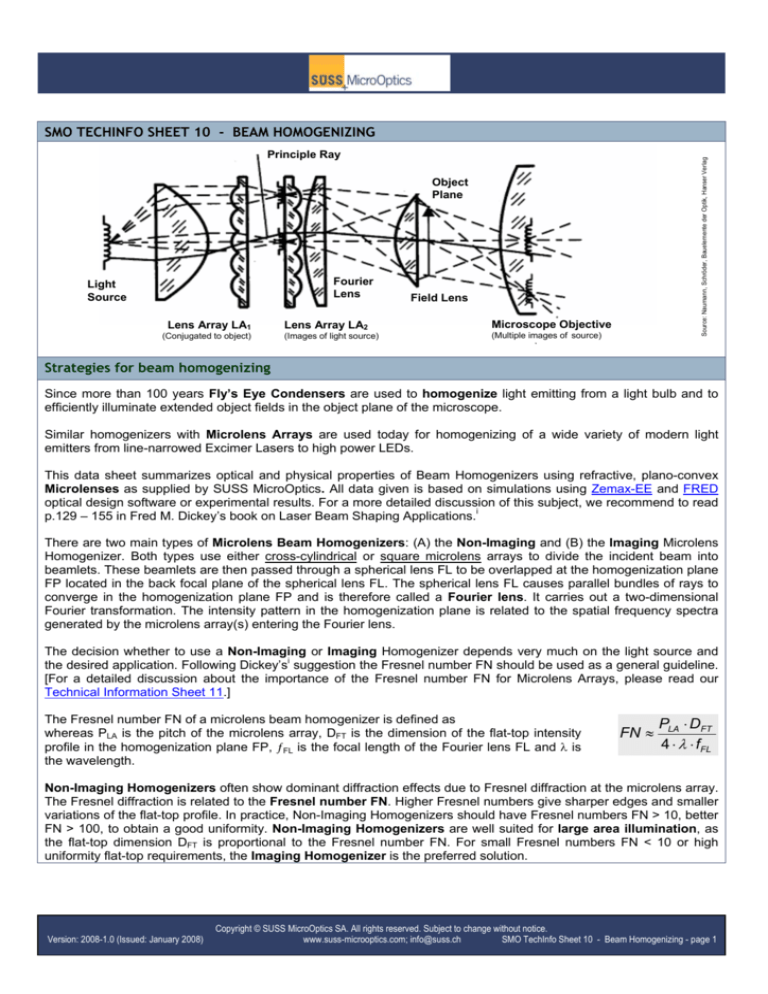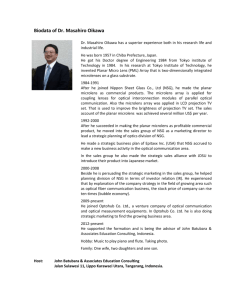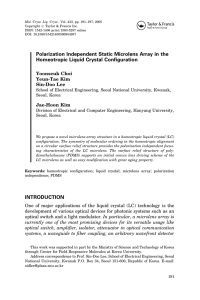
SMO TECHINFO SHEET 10 - BEAM HOMOGENIZING
Source: Naumann, Schröder, Bauelemente der Optik, Hanser Verlag
Principle Ray
Object
Plane
Fourier
Lens
Light
Source
Lens Array LA1
(Conjugated to object)
Lens Array LA2
(Images of light source)
Field Lens
Microscope Objective
(Multiple images of source)
)
Strategies for beam homogenizing
Since more than 100 years Fly’s Eye Condensers are used to homogenize light emitting from a light bulb and to
efficiently illuminate extended object fields in the object plane of the microscope.
Similar homogenizers with Microlens Arrays are used today for homogenizing of a wide variety of modern light
emitters from line-narrowed Excimer Lasers to high power LEDs.
This data sheet summarizes optical and physical properties of Beam Homogenizers using refractive, plano-convex
Microlenses as supplied by SUSS MicroOptics. All data given is based on simulations using Zemax-EE and FRED
optical design software or experimental results. For a more detailed discussion of this subject, we recommend to read
p.129 – 155 in Fred M. Dickey’s book on Laser Beam Shaping Applications.i
There are two main types of Microlens Beam Homogenizers: (A) the Non-Imaging and (B) the Imaging Microlens
Homogenizer. Both types use either cross-cylindrical or square microlens arrays to divide the incident beam into
beamlets. These beamlets are then passed through a spherical lens FL to be overlapped at the homogenization plane
FP located in the back focal plane of the spherical lens FL. The spherical lens FL causes parallel bundles of rays to
converge in the homogenization plane FP and is therefore called a Fourier lens. It carries out a two-dimensional
Fourier transformation. The intensity pattern in the homogenization plane is related to the spatial frequency spectra
generated by the microlens array(s) entering the Fourier lens.
The decision whether to use a Non-Imaging or Imaging Homogenizer depends very much on the light source and
the desired application. Following Dickey’si suggestion the Fresnel number FN should be used as a general guideline.
[For a detailed discussion about the importance of the Fresnel number FN for Microlens Arrays, please read our
Technical Information Sheet 11.]
The Fresnel number FN of a microlens beam homogenizer is defined as
whereas PLA is the pitch of the microlens array, DFT is the dimension of the flat-top intensity
profile in the homogenization plane FP, ƒFL is the focal length of the Fourier lens FL and λ is
the wavelength.
FN ≈
PLA ⋅ DFT
4 ⋅ λ ⋅ fFL
Non-Imaging Homogenizers often show dominant diffraction effects due to Fresnel diffraction at the microlens array.
The Fresnel diffraction is related to the Fresnel number FN. Higher Fresnel numbers give sharper edges and smaller
variations of the flat-top profile. In practice, Non-Imaging Homogenizers should have Fresnel numbers FN > 10, better
FN > 100, to obtain a good uniformity. Non-Imaging Homogenizers are well suited for large area illumination, as
the flat-top dimension DFT is proportional to the Fresnel number FN. For small Fresnel numbers FN < 10 or high
uniformity flat-top requirements, the Imaging Homogenizer is the preferred solution.
Version: 2008-1.0 (Issued: January 2008)
Copyright © SUSS MicroOptics SA. All rights reserved. Subject to change without notice.
www.suss-microoptics.com; info@suss.ch
SMO TechInfo Sheet 10 - Beam Homogenizing - page 1
A) NON-IMAGING HOMOGENIZER: One Microlens Array LA1, spherical lens FL
The homogenization plane FP is located at one focal length distance ƒFP behind the spherical lens FL. The
dimensions of the beam in the homogenized plane are given by DFT.
LA1
FL
FP
DFT =
PLA1
PLA1 ⋅ f FL
fLA1
DFT
ƒ1
ØIN
ƒFL
s
B) IMAGING HOMOGENIZER: Two Microlens Arrays LA1 and LA2, spherical lens FL
The homogenization plane FP is located at one focal length distance ƒFP behind the spherical lens FL. The
dimensions of the beam in the homogenized plane are given by DFT.
LA1
FL
LA2
FP
DFT = PLA1
fLA1 ⋅ fLA 2
[(fLA1 + fLA2 ) − a12 ]
where fLA1 < a12 < fLA1 + fLA 2
PLA1
ØIN
f FL
DFT
ƒ1
a12
s
a12 : separation of LA1 and LA2
ƒFL
The Imaging Homogenizer uses the first microlens array LA1 to divide the incident beam into multiple beamlets. The
second microlens array LA2, in combination with the spherical lens FL, acts as an array of objective lenses that
superimposes the images of each of the beamlets in the first array onto the homogenization plane FP.
The size of the flat-top now depends on the separation a12 of the two microlens array. This allows a variation of the
flat-top dimensions be shifting the position of the second microlens array. However, care must be taken not to
damage the second microlens array by focusing high-power laser beams into the lens material or to generate
crosstalk by overfilling the lens apertures of the second microlens array.
For Imaging Homogenizers the divergence θ (half angle) after the homogenized plane is given by
tan θ <
1 (ØIN + DFT − 2PLA )
, (D > PLA )
2
fFL
tan θ ≈
1 (ØIN + DFT )
, (D < PLA )
2
fFL
Usually, Imaging Homogenizers consist of two similar microlens arrays with identical lens pitch. Square-type lens
apertures generate a square flat top or top hat intensity distribution in the Fourier plane. Circular or hexagonal
microlenses will generate a circular respectively hexagonal flat-top.
Version: 2008-1.0 (Issued: January 2008)
Copyright © SUSS MicroOptics SA. All rights reserved. Subject to change without notice.
www.suss-microoptics.com; info@suss.ch
SMO TechInfo Sheet 10 - Beam Homogenizing - page 2
Square Microlens Array
Microlens Array LA1
FP: Overlay of magnified lens apertures
PLA
Measured profile in FP
DFT
Although these two basic principles of Microlens Beam Homogenizers seem to be quite simple, the proper system
layout for a specific illumination task is not always easy to find. There are no common cookbook recipes that work out
for all the light sources and lasers.
C) HOMOGENIZER DESIGN CONSIDERATIONS
We will now explain and discuss some additional design considerations that might be helpful for the layout of a
Microlens Beam Homogenizer system.
Microlens pitch: For standard laser beams, the overlay of some 9-10 microlenses is usually sufficient to achieve a
good flat top uniformity. Consequently, the beam diameter ØIN constrains the maximum microlens pitch PLA1 ≤ ØIN/3.
Typical homogenizers use 5x5 to 7x7 microlenses, but a larger number of microlenses do not have negative effects.
For large Excimer laser beams, homogenizers with many thousands of microlenses provide excellent flat-top profiles.
Diffraction effects: For small microlens apertures and a long focal length, i.e. for microlens beam homogenizers with a
Fresnel Number FN < 10, the flat top profile might be distorted by Fresnel diffraction at the lens apertures. Thus for
small laser beams a beam expander is usually the better solution than using microlens arrays with a very small lens
pitch.
Crosstalk: For Imaging Homogenizers the diameter of the individual beamlets at the second microlens array LA2 must
be smaller than the lens pitch to avoid an overfilling of the lens aperture and the loss of light. For a collimated laser
beam, the separation of the two microlens arrays is given by f LA1 < a < f LA1 + f LA2 . For laser beams with a significant
beam divergence the diameter of the beamlets at the second microlens array scales with the beam divergence. The
maximum allowed beam divergence for a given microlens homogenizer is tan θ ≤ PLA ( 2 f LA1 ) for a = f LA1 .
Damage: For high-power laser beams, a focusing into the material of the second microlens array or the spherical
lens must be avoided. An additional diffuser might be used to properly fill the aperture of the second microlens array.
Divergence: The beam divergence is increased by the beam homogenizer.
Coherence: Fulfilling the image condition for Imaging Beam Homogenizers holds a severe disadvantage for
coherent laser beams. Microlens arrays are periodic structures, where the pitch PLA1 is the grating period. Each
microlens array will behave like a diffraction grating and will generate diffraction orders with a period ΛFP = ƒFL⋅λ/PL1
in the homogenization plane FP.
Distorted flat top profile for a coherent laser beam due
to grating diffraction.
Version: 2008-1.0 (Issued: January 2008)
A rotating diffuser reduces the coherence and
provides a perfect flat top for coherent lasers.
Copyright © SUSS MicroOptics SA. All rights reserved. Subject to change without notice.
www.suss-microoptics.com; info@suss.ch
SMO TechInfo Sheet 10 - Beam Homogenizing - page 3
The flat top intensity pattern of a coherent laser beam is distorted by an array of spots with the diameter δx =
2ƒFL⋅λ/ØFL, whereas ØFL is the diameter of the Fourier Lens FL.
These distortions by grating diffraction and interference could be reduced by different measures:
-
A larger microlens pitch PLA1 leads to a finer period ΛFP in the Fourier plane.
A detuning of beam homogenizer components, e.g. a shift of the microlens arrays or the working plane out of its
correct positions allows reducing the modulation of the flat top profile.
A rotating ground glass diffuser plate to reduce the coherence of a cw-laser.
ROTATING DIFFUSER: For coherent cw-lasers, a rotating diffuser plate is the appropriated mean to avoid the
grating diffraction. Placing the diffuser at the focus of the beam, e.g. by using a beam expander in front of the
homogenizer, reduces the coherence by creating a new extended light sources, whereas the size of the source is
equal to the spot diameter on the rotating diffuser.
Unfortunately rotating diffusers do not work for pulsed lasers like Nd:YAG with picosecond laser pulses. Different
measures, such as stair case beam splitters are applied.
i
Reference: F.M. Dickey, S.C. Hoswade, D.L. Shealy, Laser Beam Shaping Applications, Taylor & Francis, ISBN 0-8247-5941
Version: 2008-1.0 (Issued: January 2008)
Copyright © SUSS MicroOptics SA. All rights reserved. Subject to change without notice.
www.suss-microoptics.com; info@suss.ch
SMO TechInfo Sheet 10 - Beam Homogenizing - page 4










